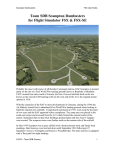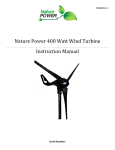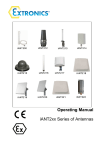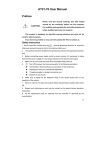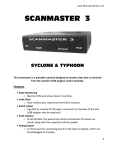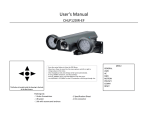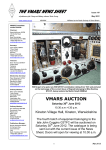Download HERE - Plane Design
Transcript
Avro Lancastrian A Plane Design Production PLANE-DESIGN AVRO LANCASTRIAN USER MANUAL V2.0 CONTENTS INTRODUCTION 3 COPYRIGHT NOTICE 3 CREDITS 3 LANCASTRIAN HISTORY 4 LANCASTRIAN SPECIFICATION 5 OPERATIONAL PROCEDURES 7 LOCATION OF CONTROLS 10 FUEL SYSTEM 13 CONTROLS & INSTRUMENTS DESCRIBED 13 THINGS YOU MIGHT NOT HAVE NOTICED 14 COPYRIGHT © 2005 PLANE-DESIGN.COM 2 PLANE-DESIGN AVRO LANCASTRIAN USER MANUAL V2.0 INTRODUCTION We present the first product from Plane Design - the Avro Lancastrian. This model includes a Virtual Cockpit with fully working controls and instruments with the added reality of animated precipitation effects. Due to the positioning of the radio in the real life cockpit, it has been added as a popup display. The external model is highly detailed with reflective skins and is fully animated. Authentic Rolls Royce Merlin engine sounds are included, allowing you to experience the mighty Lancastrian to the fullest. All major components were created using copies of the original Avro drawings, allowing us to produce a truly accurate model. C O PYR I G H T This model and all accompanying files, excluding the sextant, are a commercial product and should NOT be treated as freeware. The files may not be copied (other than for backup purposes), transmitted, passed to third parties or altered in any way without the prior permission of Plane Design. Any breach of the aforementioned copyright will result in the full force of law being brought to bear on those responsible. The bubble sextant is copyright Mark Beaumont and Dave Bitzer, and is included with their permission. Copyright © 2005 Plane Design www.plane-design.com CREDITS Visual Models Aircraft Textures Gauge Programming Sounds Flight Dynamics Testing Manual Ed Walters Ken Scott & Ed Walters Ed Walters Ed Walters Ken Scott Ken Scott, Bill Leaming Ed Walters The bubble sextant is included by kind permission of Mark Beaumont and Dave Bitzer. For details on how to use the sextant, please consult the Sextant manual. COPYRIGHT © 2005 PLANE-DESIGN.COM 3 PLANE-DESIGN AVRO LANCASTRIAN USER MANUAL V2.0 A V R O T Y P E 691 L A N C A S T R I A N H I S T O R Y The Avro Lancastrian was developed from the famous Lancaster bomber. Canadian produced Lancasters were built at Victory Aircraft in Toronto. The factory converted British built Lancaster R5727 into a passenger carrying aircraft for the Trans-Canada Air Lines. In its new guise, as the Lancaster XPP, the aircraft was flown to Britain where it was further modified by Avro. The conversion was developed further into the Lancaster Mailplane, which was later renamed the Lancastrian. In late 1943 Lancaster DV379 was the first aircraft so converted. The first aircraft built as Lancastrians (designated the Lancastrian Mk 1) were sold to British Overseas Airways Corporation (BOAC) for use on a service to Australia. These aircraft had accommodation for nine passengers on seats facing starboard which could be converted into six bunks. Luggage was carried in the nose and tail. The service was flown between Hurn, Hampshire, England and Sydney, Australia. Flights commenced on May 31st 1945, with the war still raging in the Pacific. BOAC bought 21 Lancastrian Mk Is, and operated them until 1950, latterly on freight and mail services. The Lancastrian C. Mk 2 was essentially similar to the Mk 1 and was produced for RAF Transport Command. These aircraft were used for long range flights to India, the Far East and Australia, often as VIP transport. The Mk 3 Lancastrian was developed specifically for British South American Airways (BSAA). The first flight out of Heathrow airport was on January 1st 1946, when BSAA Lancastrian G-AGWG "Star Bright" set off on a proving flight to Buenos Aires, with Captain D.C.T. Bennett at the controls. By June, a regular service to Santiago had been established. Lancastrian 3s were also supplied to Skyways, Flight Refuelling, Silver City and Alitalia. The passenger accommodation in these aircraft was side by side standard airline seats. Ten Lancastrian C. Mk.4s were supplied to RAF Transport Command, but soon were passed to civil airlines to fill the shortfall from the failure of the Avro Tudor. The Lancastrian 3, G-AGWH “Star Dust”, as depicted in this package, was lost in mysterious circumstances in the Andes on a flight to Santiago - the aircraft transmitted a Morse code message at 17:41, announcing an ETA of 17:45, followed by the mysterious word “STENDEC”, which was repeated twice. Nothing more was heard from the aircraft, until in January 2000, a Merlin engine emerged from a glacier in the Andes. The aircraft had apparently flown into the summit of Mt. Tupangato, and the wreckage had been hidden in the snow. Lancastrians operated by Flight Refuelling Ltd and Skyways also saw service in the Berlin Air Lift, between June 1948 and August 1949, from Tarrant Rushton in Dorset. Each aircraft carried between 1500 and 2300 gallons of petrol to the beleaguered city. In total, Flight Refuelling’s Lancastrians and Lancasters transported 7 million gallons, making a huge contribution to the effort. COPYRIGHT © 2005 PLANE-DESIGN.COM 4 PLANE-DESIGN AVRO LANCASTRIAN USER MANUAL V2.0 A V R O T Y P E 691 L A N C A S T R I A N S P E C I F I C A T I O N DIMENSIONS: Span: 102 ft Length: 76 ft 10 in Height: 19 ft 6 in Wing Area: 1297 sq ft POWER PLANT: Four 1280 hp Rolls Royce Merlin T24/2 /Merlin 500/2 twelve cylinder vee liquid cooled engines. Fuel capacity 2,154 Imperial Gallons in wings, 1,020 Imperial Gallons in fuselage. WEIGHTS: Tare Weight: 30,426 lb Weight Loaded: 65,000 lb Wing Loading: 50.10 lb/sq ft Power Loading: 12.7 lb/hp PERFORMANCE: Maximum speed (at 53,000lb): 295 mph at 3500 ft and 310 mph at 12,000 ft. Maximum cruising speed (weak mixture): 275 mph at 11,000ft and 285 mph at 17,500 ft Rate of climb (at 65,000lb): 750ft/min at 9500 ft and 550 ft/min at 16,000 ft. Service ceiling: 23,000 ft RANGES (under still conditions at 15,000 ft with no allowance for climb): At maximum weak mixture cruising speed (265 mph): 3570 miles At most economical cruising speed (200 mph): 4,501 miles ACCOMMODATION: Crew of two pilots, one navigator, one wireless operator, one steward, with thirteen passengers. COPYRIGHT © 2005 PLANE-DESIGN.COM 5 PLANE-DESIGN AVRO LANCASTRIAN USER MANUAL V2.0 COPYRIGHT © 2005 PLANE-DESIGN.COM 6 PLANE-DESIGN AVRO LANCASTRIAN USER MANUAL V2.0 O PE RAT I O NAL PR O C E D U R E S Before Starting [ ] Master Engine Cocks [ ] Throttles [ ] Propeller Controls [ ] Radiator Shutters [ ] Fuel tank selectors OFF Cracked open Fully up Over-ride switches at AUTOMATIC No. 2 Tanks Starting Press CTRL+E to initiate engine autostart sequence, or: FOR EACH ENGINE: [ ] Master Engine Cock ON [ ] Magnetos BOTH ON [ ] Starter Push Button Taxi-Warm-up [ ] Radiator shutters [ ] Brakes [ ] Gyro Instruments [ ] Altimeter [ ] Flight Instruments [ ] Carb Heat [ ] Navigation Lights OVER-RIDE CHECK CHECK CHECK CHECK CHECK As required Engine run-up [ ] Parking Brake SET [ ] Temperatures & Pressures CHECK [ ] Throttle 1500 RPM [ ] Suction CHECK [ ] Magneto CHECK <100 rpm drop on each; <40 rpm drop between [ ] Throttle 4 PSI [ ] Propeller Controls Check RPM falls to 1800 RPM when levers full down [ ] Throttle 24 PSI [ ] Propeller Controls Full up [ ] Boost & RPM Check takeoff settings [ ] Throttle 9 PSI COPYRIGHT © 2005 PLANE-DESIGN.COM 7 PLANE-DESIGN AVRO LANCASTRIAN USER MANUAL V2.0 Pre Take Off [ ] Auto Controls Clutch [ ] Pitot Heat [ ] Trim [ ] Flight Controls [ ] Flaps [ ] Carb Heat [ ] Heading Indicator Take Off [ ] Brakes [ ] Throttles [ ] Airspeed OUT ON Elevator slightly forward Rudder neutral Elevator neutral FREE AND CORRECT 15° to 20° COLD CHECK [ ] Landing Gear [ ] Flaps RELEASE FULL Ease aircraft off the ground at not less than 95 MPH at 50,000lb or 105 MPH at 60,000lb UP (when positive rate of climb is established) RETRACT Climb [ ] Airspeed 160 MPH for a quick climb. Most comfortable climbing speed 175 MPH After Take off and Climb [ ] Landing Gear [ ] Flaps [ ] Temperature/Pressures [ ] Landing Lights [ ] Throttles VERIFY UP VERIFY UP CHECK AS REQUIRED VERIFY FULL Cruise (Ideally at 15,000 feet MSL) [ ] Boost 7 PSI [ ] Airspeed 170 MPH [ ] RPM 1800 RPM minimum Descent [ ] Altimeters [ ] Fuel Quantity [ ] Landing Lights SET CHECK AS REQUIRED COPYRIGHT © 2005 PLANE-DESIGN.COM 8 PLANE-DESIGN AVRO LANCASTRIAN USER MANUAL V2.0 Approach [ ] Auto Controls Cock [ ] Flaps [ ] Undercarriage [ ] Propellers [ ] Flaps [ ] Airspeed OUT 20° on circuit DOWN At least 2,850RPM DOWN on final approach 110MPH-130MPH IAS After Landing [ ] Flaps [ ] Radiator shutters [ ] Landing Lights UP OVER-RIDE AS REQUIRED Engine Shut Down [ ] Parking Brakes [ ] Navigation Lights [ ] Master Engine Cocks [ ] Magnetos SET OFF OFF OFF NOTE: This aircraft's real-world checklists have been modified for use with Flight Simulator. COPYRIGHT © 2005 PLANE-DESIGN.COM 9 PLANE-DESIGN AVRO LANCASTRIAN USER MANUAL V2.0 LO CAT I O N O F C O NT R O LS 1. 2. 3. 4. 5. 6. 7. 8. 9. 10. 11. 12. 13. 14. 15. DF Indicator Undercarriage Indicator switch D.R. Compass Repeater Flaps indicator switch Ignition Switches Flaps indicator Booster coil switch Engine starter push buttons (4) Boost gauges (4) Suction gauge Vacuum change-over cock Oxygen regulator Supercharger control switches (linked together) Air supply and brakes pressure gauge Feathering push buttons (4) COPYRIGHT © 2005 PLANE-DESIGN.COM 16. 17. 18. 19. 20. 21. 22. 23. 24. 25. 26. 27. 28. 29. 30. Fire warning lights (4) Signalling switchbox (non functioning) Fire extinguisher pushbuttons (4) (non functioning) Superchargers warning light Starboard master fuel cocks (2) Throttle control levers (4) Propeller control levers (4) Port master fuel cocks (2) Signalling Switchbox DR Compass switches Identification lights switches Compass Undercarriage position indicator Beam Approach Indicator Clock 10 PLANE-DESIGN AVRO LANCASTRIAN USER MANUAL V2.0 31. 32. 33. 34. 35. 36. 37. 38. Navigation lights switch Seat raising lever Mixer Box Beam approach control unit Oxygen connection Auto controls attitude control Auto controls cock Auto controls clutch COPYRIGHT © 2005 PLANE-DESIGN.COM 39. 40. 41. 42. 43. 44. 45. 46. Brake lever Windscreen de-icer pump Flaps selector Aileron trimming control Elevator trimming control Rudder trimming control Undercarriage control lever Undercarriage control safety bolts 11 PLANE-DESIGN AVRO LANCASTRIAN USER MANUAL V2.0 47. 48. 49. 50. 51. 52. 53. Ammeter Oil pressure gauges Pressure-head heater switch Oil temperature gauges Coolant temperature gauges Fuel contents gauges Inspection lamp socket 54. 55. 56. 57. 58. 59. Fuel contents gauge switch Fuel tank selector cocks Fuel transfer switches Fuel pressure warning lights Emergency air control Oil dilution buttons (non functioning) C O N T R O L S N O T S H O W N: Cross feed cock Carburettor Heat Radiator shutter switches COPYRIGHT © 2005 PLANE-DESIGN.COM Front spar cover, under step On floor at left of pilot’s seat On starboard cockpit wall 12 PLANE-DESIGN AVRO LANCASTRIAN USER MANUAL V2.0 F U E L SYS T E M E X PLAI N E D The fuel system in the real Lancastrian had 3 tanks in each wing and one central fuselage tank, located in the position of the bomb bay in the Lancaster. The engines drew fuel from the no.1 and no.2 wing tanks; fuel could only be transferred from the no.3 tank and fuselage tanks into the no. 2 and no. 1 tanks respectively. Due to the limitations in FS2004’s fuel systems modelling, we have been forced to compromise. The main fuel selector taps allow the selection of the no. 1 and no. 2 tanks (as per the real aircraft), however, when the fuel transfer switches are selected, the engines feed from the fuselage or no. 3 tanks, as outlined by the table below. Fuel tap position Fuel transfer switch Tank in use 1 Off 1 1 On Fuselage 2 Off 2 2 On 3 When either the Fuselage or no.3 tanks are exhausted, the system will automatically switch back to the no.1 or no.2 tanks respectively. CONTROLS & INSTRUMENTS DESCRIBED As the Lancastrian instrumentation is unlike most modern instrumentation, a short description of some of the instruments and controls follows. 1. Autopilot system. In keeping with the aircraft’s age, the autopilot is very basic. It will hold the heading and attitude, and is engaged with the “AUTOPILOT CLUTCH”. The attitude setting can be altered using the “AUTO CONTROLS ATTITUDE CONTROL”. 2. The “STANDARD BEAM APPROACH” system was similar to the ILS system in modern aircraft, and we have modelled it to use the ILS signals in FS2004. The light on the left marked “O” is the Outer Beacon marker, and the one marked “I” is the Inner Beacon marker. The vertical needle at the bottom shows the lateral offset from the runway centreline and the horizontal needle shows the vertical offset from the glideslope. These needles operate in the same sense as in a conventional ILS gauge, i.e. the needle shows the direction to fly to get onto the glideslope and runway centreline. 3. The “DF INDICATOR”. This gauge will allow you to home on an ADF beacon. To home on a beacon, tune the main radio (Shift+5) to the frequency of the beacon. Unless you are pointing directly at the beacon, COPYRIGHT © 2005 PLANE-DESIGN.COM 13 PLANE-DESIGN AVRO LANCASTRIAN USER MANUAL V2.0 the needles will flick over to one side, with one needle almost horizontal, and the other needle vertical. Turn towards the vertical needle, i.e. if the right needle is vertical, turn to starboard. Eventually the needles should settle down so they are crossed over the yellow centre line. 4. The “BRAKE TRIPLE PRESSURE GAUGE” shows the air pressure to each wheel brake, and the large needle shows the system air pressure. T H I N G S YO U M I G HT N OT HAVE N OT I C E D . . . 1. When the engines are shut down and the parking brake is applied, chocks and a starter trolley will appear. 2.. If you click the side window frames, the sliding windows will open and close. 3. If you click the co-pilot’s seat and seat back, they will fold. 4. Click the armrests to move them. CLOSING REMARKS We hope that you enjoy our first release. If you have any comments or suggestions, please contact us at [email protected] We are currently developing an Avro Lancaster to complement this package, and we expect this to be released in Q1 2005, and have many exciting projects planned to follow. Ed Walters & Ken Scott - Plane Design www.plane-design.com COPYRIGHT © 2005 PLANE-DESIGN.COM 14

















